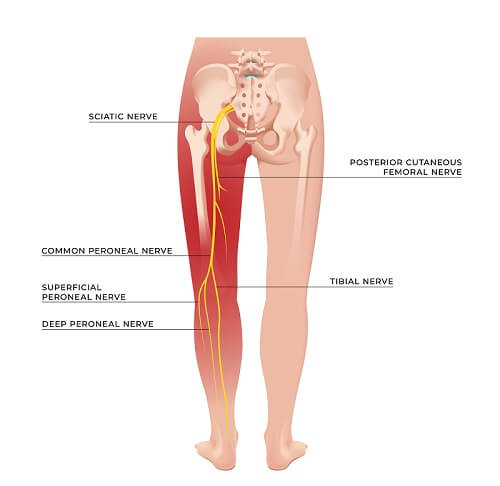Definition
The biceps femoris is a muscle found at the back of the thigh. Part of the biceps femoris belongs to the hamstrings muscle group.
The biceps femoris is a two-part spindle-shaped muscle. It has two heads: the long head and the short head. The two heads have different sites of origin and are innervated by different nerves, but they join together distally, inserting at the same location.
The functions of the biceps femoris are in controlling knee and hip joint movements. It is a commonly injured muscle in high-intensity sports.

Anatomy of the Biceps Femoris
The long head of the muscle lies posterior to the short head. If you were looking at the thigh from behind, you would only be able to see the long head, although the short head can be seen peeking out from underneath. The biceps femoris is the most lateral of the muscles in the back of the thigh, i.e., it is the closest to the outer side of the leg.
The muscle is innervated by two different divisions of the sciatic nerve: the common fibular division (which is also called the common peroneal nerve) and the tibial division. The long head of the biceps femoris is innervated by the common fibular division, whereas the short head is innervated by the common fibular division.
The Long Head
The long head has its origin on the upper and medial part of the back of the ischial tuberosity of the pelvis. Essentially, it originates from the ‘butt bone.’
The long head forms part of the hamstring muscles along with two other muscles: the semimembranosus and semimembranosus muscles. The long head of the biceps femoris muscle is the strongest muscle of the hamstring group.
The Short Head
The short head of the biceps femoris has its origin on the linea aspera and the supracondylar ridge of the femur. This is around the middle of the femur towards the knee. Therefore, the short head starts significantly lower down the leg than the long head.
The short head does not arise from the ischial tuberosity. Therefore it is not considered part of the hamstring, as arising from the ischial tuberosity is part of the criteria to be classified as one of the hamstring muscles. Interestingly, the short head shows some anatomical variation in humans and is occasionally absent altogether.

Insertion
The long head and short head come together at the distal thigh to form a tendon called the biceps femoris tendon. This tendon inserts onto the lateral side of the head of the fibula and the lateral condyle of the tibia. That is, the two heads of the muscle connect to the calf bone on the outer side of the leg and the upper and outer surface of the shin bone, near where it meets the kneecap.
Function of the Biceps Femoris
The biceps femoris muscle acts on both the knee and hip, providing movement and stability of the joints. The long head acts on both the knee and hip. In contrast, the short head acts only on the knee. The short head and the long head influence the actions the muscle takes in different ways.
The actions of the long head of the biceps femoris include flexion of the knee (bending the knee), lateral rotation of the tibia (turning the knee outwards), and extension of the hip joint (opening up the hip joint, such as stretching the leg backwards.
The actions of the short head include flexion of the knee (bending the knee) and lateral rotation of the tibia (turning the knee outwards).
Biceps Femoris-Associated Pain and Injury
The biceps femoris is the most commonly injured of the muscles in the posterior thigh. The reason for this is thought to be the innervation of the short and long heads by different nerve branches. This is believed to lead to the different parts of the muscles sometimes behaving ‘out of sync,’ making them more vulnerable to injury.
Injuries to the muscle typically occur during high-intensity exercise, particularly when hip extension occurs, such as when the leg is stretched out behind the body. Examples of activities associated with these injuries include sprinting, American football, rugby, and hockey.

These strains usually happen because of the force on the muscle; if the muscle tissue is not strong enough to withstand the forces acting upon it, the fibers will tear. This can cause intense, sharp pain at the back of the thigh and can also impact the movement and pain of the knee and hip.
To prevent such injuries, strength conditioning and stretching exercises can be carried out. These exercises will improve the flexibility and range of movement of the joint, as well as allowing the muscle to withstand increased force during exertion.
Treatment of Biceps Femoris Strains
Most biceps femoris strains can be treated by reducing the inflammation and resting the muscle, allowing it to heal. The thigh should be iced and rested, and anti-inflammatories can be taken for the pain and the swelling.
In severe cases, when the tendons have snapped or are severely torn, surgery may be an option.
Quiz
